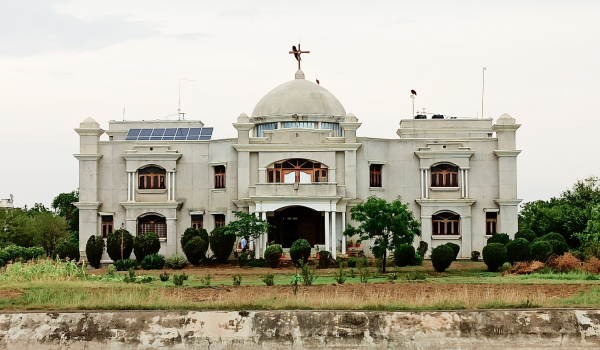
Gwalior diocese is spread over 33,583 Square Kilometers covering six districts: Bhind, Datia, Gwalior, Morena, Sheopur and Shivpuri of Madhya Pradesh.
Gwalior was the capital city of Great Maratha Sardar (knight) and warrior Maharaja Shrimant Madhavraoji Shinde and the capital of the Scindia dynasty of Gwalior state. The city is located on the periphery of Madhya Pradesh state, 321 kilometers from Delhi and 121 kilometers from Agra. The distance between Gwalior and Bhopal is 423 kilometers.
The new section of the city is called Lashkar. Lashkar is few miles south from the old city. It is the site of factories producing cotton, yarn, paint, ceramics, chemicals, and leather products. The old city is covered with white sandstone mosques, palaces, rock temples and statues of archaeological and architectural interest.
As of 2016, Gwalior has a population of 6,098,000 of which 54 percent are males and 46 percent are females. Ethnic groups in the territory include Maharahstrians, Marwaris, Sikhs and Gujarathis. Majority of the population are Hindus followed by Muslims, Sikhs, Jains and Christians.
Hindi is the main language of the people while Urdu, Marathi and Bundelkhandi are spoken.
Gwalior diocese was erected on Feb. 9, 1999, by Pope John Paul II with territory taken from the diocese of Jhansi. The vast extension of Jhansi diocese did not favor adequate development of the areas and due to the dependence on two different civil administrations, the states of Uttar Pradesh and Madhya Pradesh. Besides, there were good prospects for evangelization among the tribal population.
The present church of St. John the Baptist was built by John Baptist Filose in 1828. Father Constant Fernandez, a Goan diocesan priest, was the first residing chaplain. He worked here from 1832 to 1844. In August 1844, Father Anastasius Hartmann, a German Capuchin, succeeded him. Father Anastasius worked 18 months in Gwalior. During his stay he opened a school for the education of poor children, established an industrial center for the employment of young girls and widows, provided the station with a burial ground and education uplift of his flock. His whole idea was to make the Christians better, to get them to lead a real Catholic life.
The list of the chaplains in Gwalior is rather long. There were 33 chaplains from 1832 till it was dismembered from Agra archdiocese (established in 1886) and added to the diocese of Jhansi on July 5, 1954.
Father Joseph Kaithathara was appointed as the parish priest of St. John the Baptist Church Lashkar, Gwalior, in September 1996. On Feb. 9, 1999, he was appointed the first bishop of Gwalior diocese.
Gwalior is well connected through road, rail and air routes.
The climate can be termed as extremes, both in summer and winter. The summers are usually very hot and the winters very cold in Gwalior. The rains in Gwalior are, however, restricted only to the monsoon months. The monsoon starts usually from the first week of July and continues till the middle of September. Gwalior falls in the rain shadow zone of India. As a result, it receives an average of only 700 mm per annum, almost half of what the other places of the state receives in average.
The district literacy rate is presently 68.08 percent which is above the state literacy rate of 64.11 percent.